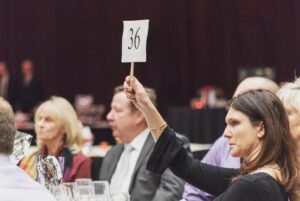The 7 Basic Rules of a Live Auction for Fundraising
Most non-profits and schools have fundraising events to help augment their operational budget to support their mission. Fundraising often includes either a silent auction or a live auction, or both.
The hardest part of having an auction is securing quality items that people will bid on. Well-meaning supporters will often donate items and experiences to help raise money for your cause, yet you will often find some of these donations to be “less than auction-worthy” and less likely to generate excitement and interest for potential bidders.
For silent auctions, we often see volunteers spend an inordinate amount of time collecting and organizing donated items and, in some cases, spending extra money to add more flair to the item. Baskets are often created to bundle smaller and similar items, often wrapped in cellophane, ready to display on long tables for viewing and bidding. A LOT of work goes into building a silent auction.
On the flip side, Live auction items are typically larger items, including vacations and experiences that are either local or abroad. Donations for the live auction are the most challenging to evaluate for worthiness, so here are a few rules to help guide you in designing the perfect live auction.

Rule #1 – Mass Appeal:
Mass appeal is the most important rule for your live auction. You have hundreds of attendees who are typically seated with their attention on the stage. If your live auction item has mass appeal, most of your guests will be interested and engage in the experience of selling the item. If not, those who are uninterested will disengage and start talking moving around, and become a distraction to those who ARE interested in the live auction item. This will lower your fundraising potential for your event.
Sometimes, a donor will submit to you a very generous donation worth hundreds or thousands of dollars. One example of a donor who generously donated a furnace for the home, with a retail value of $6,000. This is a very generous donation, however, not a mass appeal to your audience…..how many people are considering the purchase of a furnace the night of your fundraising event?
Items without mass appeal can negatively impact fundraising momentum. A difficult item to sell can impact the results for the rest of your auction. Little or no bidding creates awkwardness for your audience. Remember, even if you have one very interested bidder, you need someone equally interested in the item to create competitive bidding!
When faced with items that are not mass appeal, you will want to consider another way to use them for fundraising. This could be as a silent auction item or a raffle prize.
Rule #2 – Hard-to-Find, Hard-to-Get
Items with uniqueness are very appealing to your attendees, who will be pleasantly surprised when you offer something they cannot get easily on their own. Tickets to a concert or sporting event, or a special travel destination that includes special experiences will create interest amongst potential bidders.
Conversely, a mass-appeal item that is easy to obtain on your own is likely not going to perform well in your live auction. For example, if you have a Big Screen TV donated, you can certainly presume there is mass appeal. However, since there are unlimited channels to purchase a TV, you will likely see your audience revert to “bargain-shopping” as they compare the bidding level to what they can purchase a similar TV on their Costco app on their phone!
Curating items that bidders can not find easily brings more intrigue and higher bidding to your live auction. These items also create more buzz about your event. These items can also become the WOW factor for your event!
Rule #3 – Flexibility
You will sometimes receive a generous donation from a well-meaning supporter who has restrictions on the use of the donation. Those restrictions can inhibit bidding and interest. For example, if the donation includes a specific date range for use, bidders in the room who are already busy during that date range will disengage and not be bidding on the item.
Flexibility comes in many flavors. Ideally, a donated item should be offered with very few restrictions for the buyer. A donation of a timeshare condo in Naples, Florida, for the week of August 5th-12th sounds wonderful, but how many people like to head to Florida in the month of August?
If the experience has blackout dates or a short time to use, this will inhibit bidding and interest by your audience. Ideally, you can ask your donating supporter to expand the flexibility for the use of the item to improve results. If not, maybe the item should be used elsewhere, such as a silent auction item or as a raffle item.
There are many companies like Mission First Fundraising that offer packages with robust flexibility in terms of when you want to travel, where you want to travel, and how you want to travel. These packages perform better than similar packages with restrictions, up to 250% higher ROI in a live auction.
Rule #4 – Balance
A live auction should have something for everyone. Most of you will typically have 6-10 items in your live auction, which will take 20-30 minutes to describe and sell to your audience. How do you keep everyone in the room’s attention during those 30 minutes?
The answer is to provide a variety of categories of items that will cater to different people in the audience. For example, having all golf foursomes donated by various supporters will not capture the attention of those who are not golfers in the room.
Balance comes in many ways. First, you want balance in terms of the categories of items, such as travel, sporting events, activities, experiences, memorabilia, etc.
Second, you want to have items that cover different categories such as local interest, domestic interest, and international interest, which can simply be a beach vacation down south, somewhere sunny!
Third, you want to provide items that are in line with the budget for all levels of income. Most of your items will be packages everyone can afford, while other live auction items can be higher-end items for your higher net-worth attendees.
Fourth, you will want to include balance in terms of providing packages that vary in the number of travelers or attendees who can participate. Some people prefer to travel alone with their spouse or significant other, while others like to travel with their family or with a larger group of couples. For example, having a live auction item for a Pig Roast for 40 ppl can be very appealing to some, while a trip for 2 to Tuscany can be more suitable to others.
You can find different categories of live auction items on our package list at www.missionfirstfundraising.org for more ideas. Choose 5-6 categories that you prefer for your audience. For each category, see if you can secure a suitable donated item from a donor first, then use this site to fill in the gaps to create a well-balanced live auction lineup.
TIP: Start by building the dream lineup. Use the site above to generate ideas. Once you have the dream lineup in mind, then work to replace it with acceptable donated items. Use your dream lineup to make specific asks from your board or key supporters who have donated in the past. (eg. “Do you have access to concert tickets for this show?”)
Rule #5 – The “WOW” Factor
This is a bonus rule to really ignite your live auction, but finding that one item that will create buzz at your event can become your signature moment for fundraising. The WOW factor item will create interest for everyone in the room, even if they can’t afford it or who do not expect to be the winning bidder.
An example of a WOW factor item could be a special concert with a meet and greet or some special destination or restaurant that is impossible to get reservations for. These items get your audience buzzing, sometimes for weeks and months after your event. It is one of those signature moments that can energize the entire room, which accelerates fundraising.
Rule #6 – Sequencing of items
The sequence of your items will also impact your fundraising success. Start your live auction with a universally mass-appeal item that everyone can afford. Follow this with a sequence of different categories. For example, if you have decided on 8 items for your live auction, imagine you will have 2 local experiences, 2 sports-related items, 2 domestic trips, and two international destinations. Rather than random placement of these items, alternate the sequence of these items, such as this example live auction lineup:
Local – weekend getaway for 2
Sports – tickets to a game, suite for 12
Domestic – weekend getaway to the lake
International – trip for 2 to Tuscany (can sell unlimited)
Sports – Golf Stay-and-Play package
Domestic – Wine and Train experience in Napa Valley
International – All-inclusive beach destination for 2
Local – in-home private chef dinner for 8 people (can sell two)
You also may want to look at the value of each item and design your sequence to build momentum toward those items that are of higher value to be sold near the end. A bell curve approach is typically recommended. In the scenario above, items 6 & 7 would be your higher-value items in the live auction. Items 1 & 8 are likely the most affordable items, which can also have the most mass appeal.
Rule #7 – Selling more than one
A great live auction will have one or two items that you are allowed to sell more than one of. As you will often see in competitive bidding, there is often a disappointed bidder who lost out on the bidding yet will be pleasantly surprised that there is the potential that they can buy a 2nd trip or experience. This should always be a surprise to the audience, but your auctioneer should have these in their back pocket and can offer at just the right time.
Selling multiples can become a momentum builder itself. In some cases, unlimited multiples can be a way to dramatically extend your fundraising, as multiple bidders can purchase the item at a great value. A trained auctioneer can help you set up these scenarios for maximum effectiveness.
We like to call this the “Oprah Moment.” Instead of raising a couple thousand dollars for an item that you have one of, selling multiples could result in raising $50,000 or more in the same amount of time, depending on your audience size. Be sure to evaluate a potential “Oprah Moment” for your event.
Summary
Applying these rules to your development of the live auction will ensure you can maximize the success of your fundraising. Use these rules to socialize with your committees as you decide which items should be in your live auction.
Put every item through a lens that protects your fundraising. Not every item has to meet every rule above. But as you collect items for your live auction, this is a way to grade and evaluate from a larger pool of potential items and then cull your list to the very best items for your live auction.
Please comment on this blog post. You can also sign up for our newsletter to get more articles like this at www.missionfirstfundraising.org






